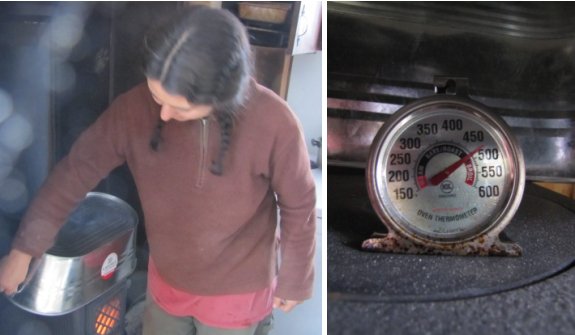
How to bake with a wood stove

This experiment is still in
the planning stages...but one of these small metal tubs placed on
top of the Jotul
F 602 wood stove does a good job at reaching temperatures suitable
for baking.
The goal is to see if it's
possible or practical to bake muffins.
Of course the temperature
will depend on the size of the fire, but this first test proves that
reaching the main baking temperature of 350 degrees is indeed workable.
The idea is to use a couple of fire bricks to support the muffin pan
which might be enough to prevent the pan from getting too hot and
burning the product.
Want more in-depth information? Browse through our books.
Or explore more posts by date or by subject.
About us: Anna Hess and Mark Hamilton spent over a decade living self-sufficiently in the mountains of Virginia before moving north to start over from scratch in the foothills of Ohio. They've experimented with permaculture, no-till gardening, trailersteading, home-based microbusinesses and much more, writing about their adventures in both blogs and books.
Want to be notified when new comments are posted on this page? Click on the RSS button after you add a comment to subscribe to the comment feed, or simply check the box beside "email replies to me" while writing your comment.

Interesting to see that a plain metal tub (which should leak heat like the proverbial sieve) seems to be able to contain the temperature that well.
Did you also measure with e.g. a fire brick between the top of the stove and the thermometer to get the air temperature? It could be showing a higher than ambient value because of the metal-metal contact between the stove and the thermometer.
By warming up bricks, they will continue to radiate heat for HOURS. So, heat up a bunch of bricks, lay them on the ground to make a brick floor. Then make your walls and so forth.
The bricks will radiate heat for HOURS. Just be careful, Alton Brown once built his brick oven on gravel, and melted sprinker lines that were buried 6 inches under ground.
This method will serve you better most likely. The book by alton brown, I'm just here for the food has a diagram and everything. He does it just because the bricks radiate heat evenly from all directions, while metal ovens heat from primarily underneath, and then bounce that head all over metal walls, creating uneven cooking. So he does it just for the fu-fu taste increase on a pizza.
Justin --- that sounds like you'd get good results, but sounds like an awful lot of work for one baking expedition! If I was going to do that, I'd probably just go ahead and build a wood-burning oven outdoors.
Eliza --- that's precisely what has scared me off in the past, but this spring we accidentally wiped the temperature measurements off the old dial on our ancient electric stove, so I started baking by eye. That has made it much easier for me to make the move to the wood stove, and I highly recommend it.
Hi Anna, it makes my evening reading your cooking experiments, if you want to bake in the method described above, once you gauge your temperatures and get the fire feeding right, you will need to use a baking rack (round one that fits on the plate of the stove) to lift your cake or muffins off the plate to prevent burning, should you start to overheat, tip the tub to release the heat, also you can purchase a probe thermometer (http://www.google.com/products/catalog?q=probe+thermometer&hl=en&rls=com.microsoft:en-us:IE-SearchBox&rlz=1I7ADRA_en&prmd=ivns&resnum=3&biw=1259&bih=529&wrapid=tlif12947920166871&um=1&ie=UTF-8&cid=18106539488677377593&ei=ZPUsTeXQIsP48AbRtKiRCQ&sa=X&oi=product_catalog_result&ct=result&resnum=1&ved=0CHAQ8wIwAA#) this has a three foot sensor cable heat resistance and you can monitor the heat and release access heat as needed. It cost $ 21.00 but I am sure it would be worth it not to burn you baked goods Darryl
Darryl --- it makes my day to make your evening! I like your idea of using baking racks instead of fire bricks --- we're clearly going to have to try both!
I like your idea of using baking racks instead of fire bricks --- we're clearly going to have to try both!
(Don't tempt me with more thermometers! I don't know how many thermometers Mark will let me get in one week. )
)